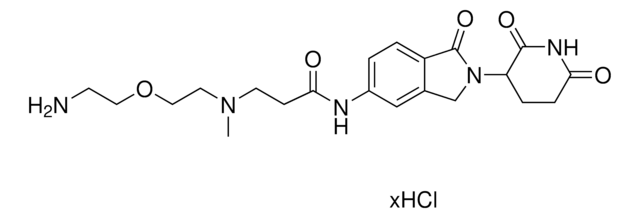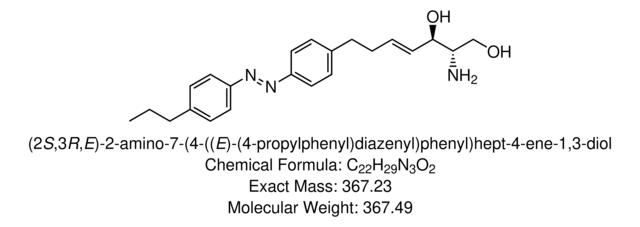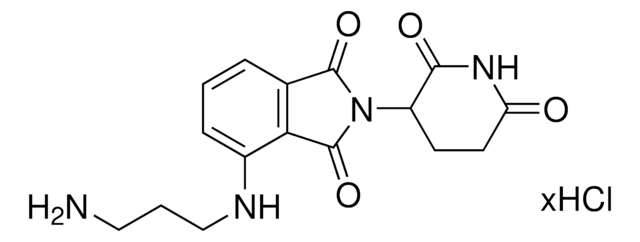918091
Lenalidomide-Photoswitch2-NH2 hydrochloride
≥95%
Sinonimo/i:
(E)-N-(2-Aminoethyl)-2-(4-((2-(2,6-dioxopiperidin-3-yl)-1-oxoisoindolin-4-yl)diazenyl)phenoxy)acetamide hydrochloride, PHOTAC template, Photoswitchable protein degrader building block for PROTAC® research
About This Item
Prodotti consigliati
ligand
lenalidomide
Livello qualitativo
Saggio
≥95%
Forma fisica
powder or crystals
Impiego in reazioni chimiche
reactivity: carboxyl reactive
reagent type: ligand-linker conjugate
Gruppo funzionale
amine
Temperatura di conservazione
2-8°C
Stringa SMILE
NCCNC(COC1=CC=C(/N=N/C2=CC=CC3=C2CN(C4C(NC(CC4)=O)=O)C3=O)C=C1)=O.Cl
Categorie correlate
Applicazioni
Suggested wavelengths for photoswitching:
- Switch to cis isomer: 390 nm (380-400 nm)
- Switch to trans isomer (thermally more stable isomer): >450 nm
Low-intensity light needed for photoactivation is not cytotoxic.
Browse our full offering of degrader building blocks that streamlines the synthesis of degrader libraries.
Product can be used with our line of photoreactors: Including Penn PhD (Z744035) & SynLED 2.0 (Z744080)
Altre note
Note legali
Prodotti correlati
Codice della classe di stoccaggio
11 - Combustible Solids
Classe di pericolosità dell'acqua (WGK)
WGK 3
Punto d’infiammabilità (°F)
Not applicable
Punto d’infiammabilità (°C)
Not applicable
Certificati d'analisi (COA)
Cerca il Certificati d'analisi (COA) digitando il numero di lotto/batch corrispondente. I numeri di lotto o di batch sono stampati sull'etichetta dei prodotti dopo la parola ‘Lotto’ o ‘Batch’.
Possiedi già questo prodotto?
I documenti relativi ai prodotti acquistati recentemente sono disponibili nell’Archivio dei documenti.
Articoli
Protein Degrader Building Blocks are a collection of crosslinker-E3 ligand conjugates with a pendant functional group for covalent linkage to a target ligand.
Il team dei nostri ricercatori vanta grande esperienza in tutte le aree della ricerca quali Life Science, scienza dei materiali, sintesi chimica, cromatografia, discipline analitiche, ecc..
Contatta l'Assistenza Tecnica.

![4-[4-(Dimethylamino)phenylazo]benzoic acid N-succinimidyl ester ≥98.0% (HPLC)](/deepweb/assets/sigmaaldrich/product/structures/120/235/500b5276-3ce2-43b7-9588-3883f13d4ff7/640/500b5276-3ce2-43b7-9588-3883f13d4ff7.png)






